




OUR BEST EVER OFFER - SAVE £100/$100
JOIN THE WORLD'S LEADING PROFESSIONAL DEVELOPMENT PROGRAMME
- 12 months membership of Elite Soccer
- Print copy of Elite Player & Coach Development
- Print copy of The Training Ground
You are viewing 1 of your 1 free articles
Overlapping
Moving the opposition back four with switches of play and timing of overlaps is a vital part of any offensive side’s armoury, which is why this session looks at creating crossing opportunities high up the pitch by manufacturing 2v1 overlaps and overloads.
| Area | Up to 54x36 yards |
| Equipment | Balls, cones, goals |
| No. of Players | 22 |
| Session Time | Pass and overlap drill 15mins, Game-related practice 15mins, plus 10min progression |
This session is about creating crossing opportunities high up the pitch by manufacturing 2v1 overlaps and overloads. It’s important to practise this because moving the opposition back four with switches of play and timing of overlaps is a vital part of any offensive side’s armoury, whether or not the final attack goes out wide for a cross.
What do I get the players to do?
Pass and overlap drill
We begin in a 30x15-yard area, with two players at each end. A passes to B, who then drives diagonally into the area (1a). A overlaps and receives the ball, passing onwards to C (1b). Working players now vacate the area, and the link-up play is then repeated as the move comes back in the other direction.
1a
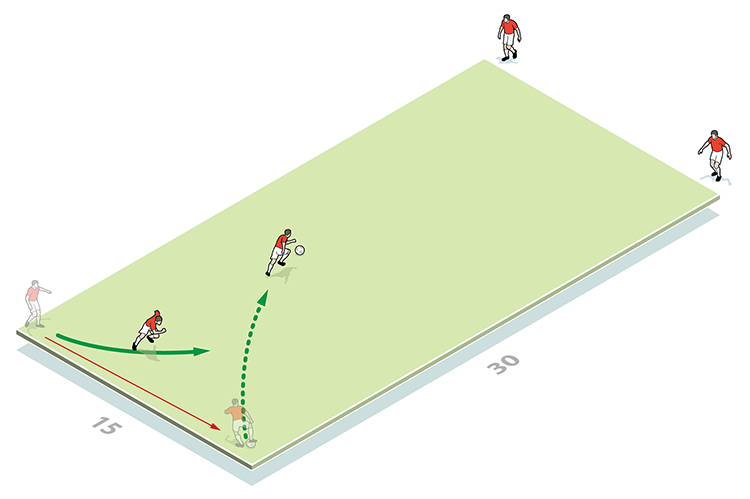
1b
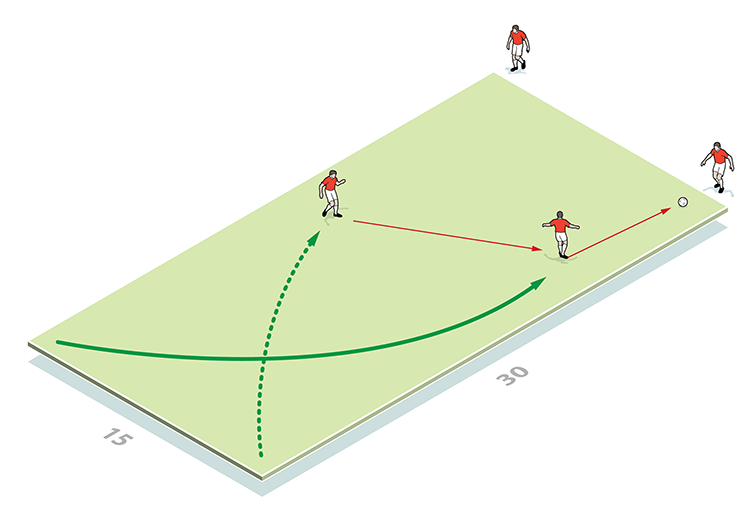
What are the key things to look out for?
We want to see good weight and accuracy of pass. Communication from A is so important in terms of when and to where the ball is released on the overlap.
At first, build slowly and use repetition so that the process becomes second nature. Then ask for players to quicken the pace when they feel more comfortable.
Game-related practice
The game is performed in an area comprised of two penalty boxes placed together, plus 5-yard zones on either side. It’s 8v8 in the main area, and there is a player from both teams on each flank (2a).
2a
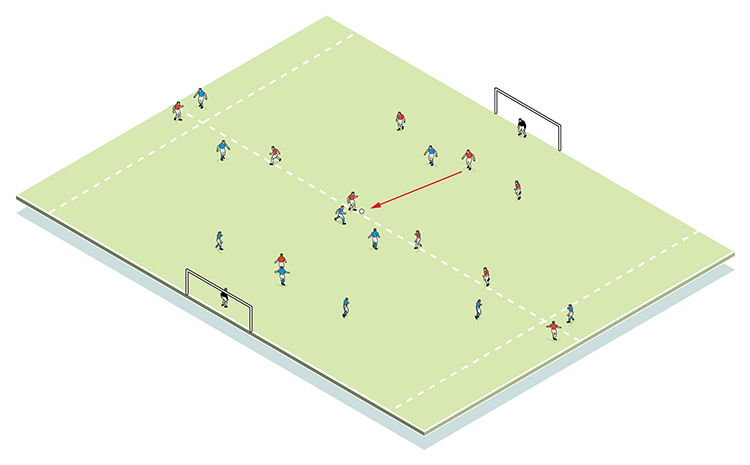
On the flanks, the defending player cannot tackle, so when the ball is fed wide the attacker overlaps, receives the ball, and moves forward preparing to cross (2b). This player needs to recognise the ‘trigger’ to move, namely the infield wide man driving inside, as practised in ‘Pass and overlap drill’.
2b
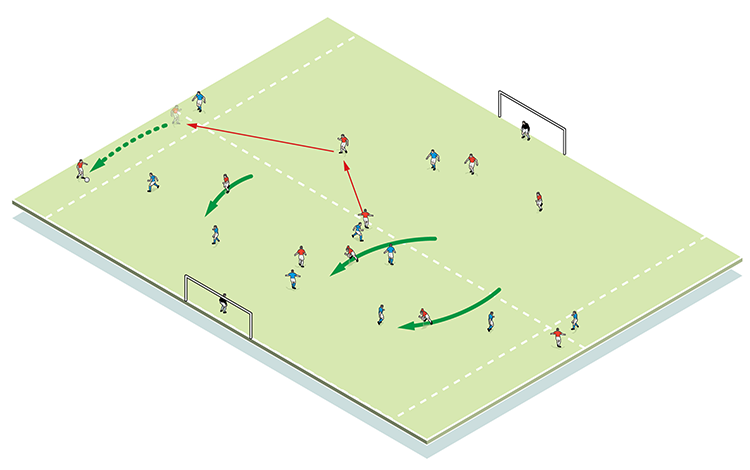
How do I progress the session?
We now make the session opposed. So when the wide attacker takes his first touch, his opposing defender and any infield defender can engage, making a 2v1 (3a/3b). Can the winger find an attacker to restore the situation to a 2v2? Can he create a 2v1 attacking overload and make room for a precise cross into the box? Later, we might also remove the wide zones to make it as game realistic as possible.
3a
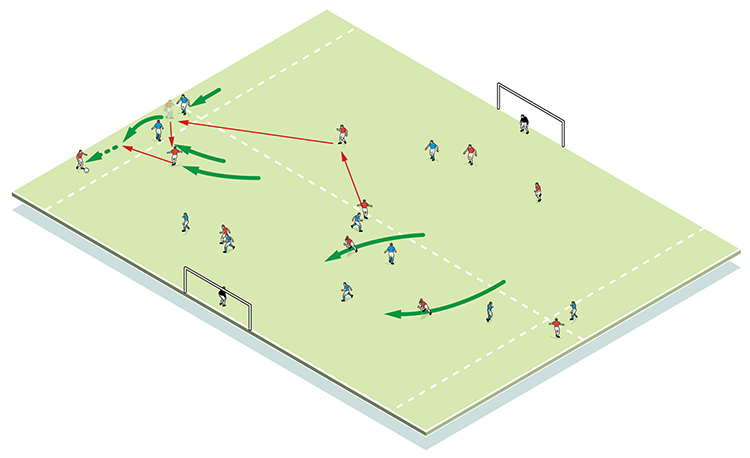
3b
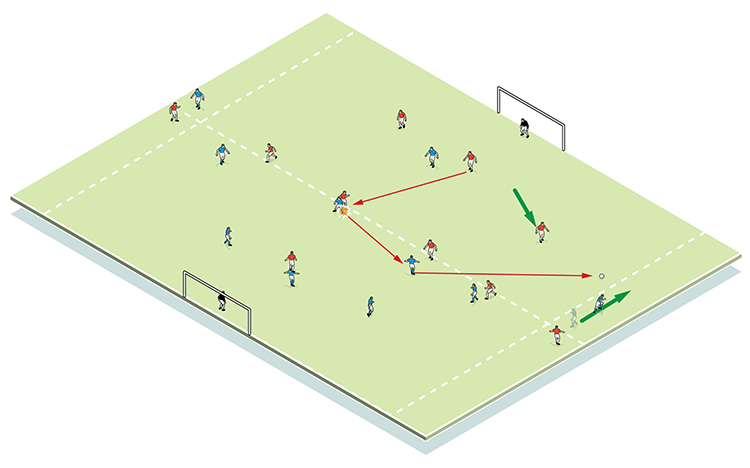
What are the key things to look out for?
We’re looking for timing of runs, good communication between attackers, plus good passing weight and accuracy. It’s important that the overlapping player does not get ahead of the ball, so well-timed runs are vital.
Related Files
Editor's Picks
Attacking transitions
Deep runs in the final third
Using the goalkeeper in build-up play
Intensive boxes drill with goals
Penetrating the final third
Creating and finishing
My philosophy
Pressing initiation
Compact team movement
Coaches' Testimonials

Alan Pardew

Arsène Wenger

Brendan Rodgers

Carlos Carvalhal

José Mourinho

Jürgen Klopp

Pep Guardiola

Roy Hodgson

Sir Alex Ferguson

Steven Gerrard
Coaches' Testimonials

Gerald Kearney, Downtown Las Vegas Soccer Club

Paul Butler, Florida, USA

Rick Shields, Springboro, USA

Tony Green, Pierrefonds Titans, Quebec, Canada
Join the world's leading coaches and managers and discover for yourself one of the best kept secrets in coaching. No other training tool on the planet is written or read by the calibre of names you’ll find in Elite Soccer.
In a recent survey 92% of subscribers said Elite Soccer makes them more confident, 89% said it makes them a more effective coach and 91% said it makes them more inspired.
Get Monthly Inspiration
All the latest techniques and approaches
Since 2010 Elite Soccer has given subscribers exclusive insight into the training ground practices of the world’s best coaches. Published in partnership with the League Managers Association we have unparalleled access to the leading lights in the English leagues, as well as a host of international managers.
Elite Soccer exclusively features sessions written by the coaches themselves. There are no observed sessions and no sessions “in the style of”, just first-hand advice delivered direct to you from the coach.







